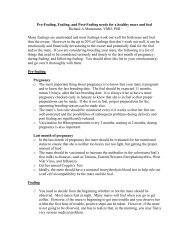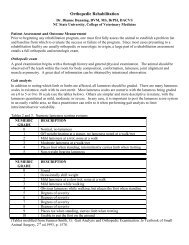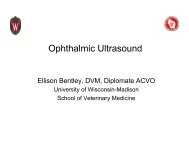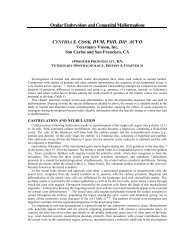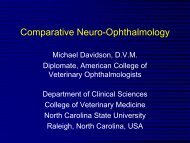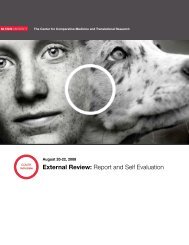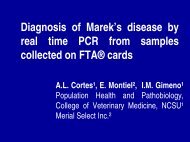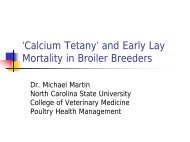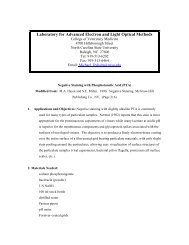questions related to interpretation of the idexx snap 3dx
questions related to interpretation of the idexx snap 3dx
questions related to interpretation of the idexx snap 3dx
Create successful ePaper yourself
Turn your PDF publications into a flip-book with our unique Google optimized e-Paper software.
QUESTIONS RELATED TO INTERPRETATION OF THE IDEXX SNAP 4DX<br />
Ed Breitschwerdt, DVM<br />
Pr<strong>of</strong>essor <strong>of</strong> Medicine and Infectious Diseases<br />
North Carolina State University<br />
College <strong>of</strong> Veterinary Medicine<br />
Veterinarians play a central role in <strong>the</strong> diagnosis, treatment and prevention <strong>of</strong> ticktransmitted<br />
infectious diseases <strong>of</strong> companion animals. Veterinarians also play an<br />
increasingly important role in advising <strong>the</strong> public as <strong>to</strong> <strong>the</strong> zoonotic potential <strong>of</strong><br />
organisms that are transmitted from ticks <strong>to</strong> pets or <strong>to</strong> <strong>the</strong>ir owners.<br />
The SNAP 4DX test detects Dir<strong>of</strong>ilaria immitus antigen, antibodies directed against<br />
Borrelia burgdorferi C-6 peptide, antibodies <strong>to</strong> two syn<strong>the</strong>tic Ehrlichia canis<br />
immunodominant proteins and antibodies <strong>to</strong> Anaplasma phagocy<strong>to</strong>philum<br />
immunodominant peptides.<br />
Borrelia burgdorferi:<br />
Clinical Application: The C-6 peptide <strong>of</strong> B. burgdorferi is a highly specific diagnostic<br />
peptide that is used <strong>to</strong> detect B. burgdorferi antibodies in dog sera. Infection with closely<br />
<strong>related</strong> bacteria or prior vaccination with a “Lyme Disease” vaccine will not result in<br />
antibodies <strong>to</strong> B. burgdorferi C-6 peptide. However, when used as an annual screening<br />
test, occasional false positive test results should be anticipated. To date, all C-6 peptide<br />
positive test results confirmed by <strong>the</strong> Vec<strong>to</strong>r Borne Diseases Diagnostic Labora<strong>to</strong>ry at<br />
NCSU-CVM have been in dogs with a travel (and tick exposure) his<strong>to</strong>ry north <strong>of</strong><br />
Richmond, Virginia. Although B. burgdorferi transmission may be occurring in focal<br />
sites in <strong>the</strong> sou<strong>the</strong>astern United States, <strong>to</strong> date, we have not confirmed a C-6 SNAP<br />
positive test result in a dog indigenous <strong>to</strong> North Carolina. (See <strong>the</strong> reference citation<br />
below) Questionable B. burgdorferi positive test results (i.e. any C-6 peptide positive<br />
dog that lacks a travel his<strong>to</strong>ry outside <strong>of</strong> North Carolina) should be fur<strong>the</strong>r examined by<br />
Western immunoblot at Cornell University. We would be very interested hearing about<br />
any C-6/WB positive dogs that have never traveled outside North Carolina.<br />
Treatment: Based upon current data, I do not recommend treatment <strong>of</strong> C-6 antibody<br />
positive dogs, unless <strong>the</strong>re is concurrent clinical disease. (See <strong>the</strong> ACVIM Consensus<br />
Statement on Lyme Disease in Dogs) To date, Lyme disease in dogs is characterized by<br />
lameness, which can be intermittent and self-limiting without antibiotic <strong>the</strong>rapy. Less<br />
well documented abnormalities include encephalitis, myocarditis and acute renal failure<br />
(particularly in Labrador and Golden Retrievers). Although antibiotic treatment can<br />
enhance <strong>the</strong> resolution <strong>of</strong> lameness, no antibiotic has been proven <strong>to</strong> be curative. If we<br />
can not cure <strong>the</strong> infection, treatment <strong>of</strong> a healthy dog is more difficult <strong>to</strong> justify.
2<br />
Ehrlichia canis:<br />
Clinical Application: The SNAP 4DX test detects antibodies <strong>to</strong> two syn<strong>the</strong>tic E. canis<br />
immunodominant proteins. Due <strong>to</strong> serological cross reactivity, <strong>the</strong> test will be positive in<br />
dogs previously exposed <strong>to</strong> E. canis or E. chaffeensis. Dogs infected with Ehrlichia<br />
ewingii or Anaplasma phagocy<strong>to</strong>philum (previously Ehrlichia equi) do not produce<br />
antibodies that cross react with <strong>the</strong>se E. canis peptides. Therefore a dog can have chronic<br />
ehrlichiosis, due <strong>to</strong> E. ewingii infection, which will not be detected by reactivity <strong>to</strong> <strong>the</strong> E.<br />
canis peptides in <strong>the</strong> 4DX test.<br />
The SNAP 4DX test is intended <strong>to</strong> be used as a screening test, not a diagnostic test. For<br />
this reason, <strong>the</strong> test does not detect low E. canis antibody titers (i.e. most IFA titers below<br />
1:256 will result in a negative test result). When used as a screening test, statistics dictate<br />
that occasional false positive test results should be anticipated. False positive results can<br />
be clarified by IFA and PCR testing. Failure <strong>to</strong> provide a specific antibody titer, (an<br />
indication <strong>of</strong> antibody concentration in <strong>the</strong> dog’s serum) is one disadvantage <strong>of</strong> <strong>the</strong> E.<br />
canis component <strong>of</strong> <strong>the</strong> 4DX test as compared <strong>to</strong> IFA testing. Some veterinarians elect <strong>to</strong><br />
confirm all E. canis SNAP positive results by performing an IFA titer and PCR for <strong>the</strong><br />
detection <strong>of</strong> E. canis or o<strong>the</strong>r Ehrlichia species DNA (this confirms active infection).<br />
Treatment: Following introduction <strong>of</strong> <strong>the</strong> SNAP test, <strong>the</strong> VBDDL participated in a<br />
collaborative study with IDEXX labora<strong>to</strong>ries <strong>to</strong> determine <strong>the</strong> extent <strong>to</strong> which E. canis<br />
SNAP positive, healthy dogs are IFA seroreactive and actively infected based upon PCR<br />
testing. In 86 E. canis SNAP+ samples submitted by regional veterinary hospitals from<br />
untreated dogs, 58% <strong>of</strong> <strong>the</strong> dogs were thrombocy<strong>to</strong>penic, 99% IFA seroreactive and 14%<br />
PCR +. It does appear that some dogs, naturally infected with E. canis, are capable <strong>of</strong><br />
mounting an effective immunological response that eliminates <strong>the</strong> organism. These dogs<br />
would mount an antibody response detectable by SNAP or IFA, but have normal<br />
hema<strong>to</strong>logical findings and would be PCR negative. (Caution: A negative PCR result<br />
can support immunological or <strong>the</strong>rapeutic elimination <strong>of</strong> an infection, but can never<br />
completely confirm that an individual animal is not infected with a given organism).<br />
When veterinarians tested sick dogs, <strong>the</strong> presence <strong>of</strong> antibody appeared <strong>to</strong> correlate with<br />
active infection, regardless <strong>of</strong> <strong>the</strong> level <strong>of</strong> <strong>the</strong> antibody titer. This may not be true in <strong>the</strong><br />
healthy dog population. If a positive E. canis SNAP result is obtained on a healthy dog, I<br />
would recommend examination <strong>of</strong> a complete blood count prior <strong>to</strong> treatment. If <strong>the</strong> dog<br />
is anemic, neutropenic, thrombocy<strong>to</strong>penic or hyperglobulinemic, <strong>the</strong>n treatment with<br />
doxycycline 5 mg/kg every 12 hours for 4 weeks (See ACVIM Consensus Statement on<br />
Canine Ehrlichiosis) would be recommended. If <strong>the</strong> complete blood count values are<br />
within normal reference ranges, treatment may not be indicated. Alternatively, <strong>the</strong> SNAP<br />
test result can be confirmed by IFA testing and <strong>the</strong> current infection status <strong>of</strong> <strong>the</strong> dog can<br />
be determined by PCR testing. PCR detects Ehrlichia genus DNA and <strong>the</strong>refore will<br />
detect all known Ehrlichia species. In our labora<strong>to</strong>ry <strong>the</strong> design <strong>of</strong> this PCR test allows<br />
for <strong>the</strong> detection <strong>of</strong> all Anaplasma species, as well as all Ehrlichia speices. If <strong>the</strong> genus<br />
PCR is positive, <strong>the</strong> dog is actively infected and treatment would be indicated.
3<br />
Although our experience <strong>to</strong> date is limited, some dogs may remain E. canis SNAP<br />
positive one year after an initial positive SNAP test result and following appropriate<br />
treatment with doxcycline. When tested by both IFA and PCR (one year post-treatment)<br />
nei<strong>the</strong>r antibodies nor DNA was detected suggesting that <strong>the</strong> infection was<br />
<strong>the</strong>rapeutically or immunologically eliminated. This preliminary observation should be<br />
considered when repeating an annual test on a dog that was previously E. canis positive<br />
by SNAP.<br />
Anaplasma phagocy<strong>to</strong>philum<br />
Anaplasmosis, caused by A. phagocy<strong>to</strong>philum, is characterized by an acute, febrile illness<br />
in cats, dogs, horses and human beings. Anaplasma phagocy<strong>to</strong>philum can also infect<br />
numerous o<strong>the</strong>r wild animal species that serve as reservoir hosts for subsequent<br />
transmission by Ixodes scapularis, Ixodes pacificus and perhaps o<strong>the</strong>r tick species.<br />
Clinical Application: The SNAP 4DX test detects antibodies <strong>to</strong> a syn<strong>the</strong>tic A.<br />
phagocy<strong>to</strong>philum immunodominant protein. Due <strong>to</strong> serological cross reactivity, <strong>the</strong> test<br />
will also be positive in dogs previously exposed <strong>to</strong> Anaplasma platys, <strong>the</strong> cause <strong>of</strong> cyclic<br />
canine thrombocy<strong>to</strong>penia. Anaplasma platys appears <strong>to</strong> be transmitted by <strong>the</strong> brown dog<br />
tick, Rhipicephalus sanguineus. Based upon PCR testing, canine anaplasmosis is<br />
frequently encountered in sick dogs and people in <strong>the</strong> nor<strong>the</strong>astern, north central and<br />
north western United States and sou<strong>the</strong>rn Canada. Due <strong>to</strong> transmission by <strong>the</strong> same tick<br />
vec<strong>to</strong>r (I. scapularis or I. pacificus) in <strong>the</strong> United States, co-infections with B.<br />
burgdorferi and A. phagocy<strong>to</strong>philum are common in “Lyme-endemic” regions. Dogs<br />
infected with A. phagocy<strong>to</strong>philum can develop only mild illness or perhaps no clinically<br />
apparent illness at all. Dogs co-infected with B. burgdorferi and A. phagocy<strong>to</strong>philum are<br />
more likely <strong>to</strong> develop severe disease signs. Experimentally, dogs can develop chronic A.<br />
phagoctyophilum infection in <strong>the</strong> absence <strong>of</strong> clinical signs <strong>of</strong> disease. The extent <strong>to</strong><br />
which natural A. phagocy<strong>to</strong>philum infection following tick transmission results in chronic<br />
infection or induces chronic disease manifestations is unknown. In contrast, infection<br />
with A. platys can induce chronic infection, accompanied by a moderate <strong>to</strong> severe cyclic<br />
thrombocy<strong>to</strong>penia, but generally without accompanying severe clinical manifestations.<br />
An Anaplasma SNAP+ dog that has resided in <strong>the</strong> sou<strong>the</strong>astern United States is more<br />
likely <strong>to</strong> have been exposed <strong>to</strong> A. platys, which is a relatively common tick borne<br />
infection, as compared <strong>to</strong> A. phagoctyophilum, which is infrequently transmitted <strong>to</strong> cats,<br />
dogs, horses or human beings in <strong>the</strong> sou<strong>the</strong>astern US (similar <strong>to</strong> data relative <strong>to</strong> patterns<br />
<strong>of</strong> B. burgdorferi transmission).<br />
Treatment: Treatment <strong>of</strong> healthy Anaplasma SNAP+ dogs in Lyme-endemic regions is<br />
not currently recommended as <strong>the</strong>re is limited evidence that detection <strong>of</strong> antibodies<br />
correlates with chronic infection due <strong>to</strong> A. phagocy<strong>to</strong>philum. PCR could be used <strong>to</strong><br />
establish chronic or recurrent infection due <strong>to</strong> A. phagocy<strong>to</strong>philum. Anaplasma SNAP+<br />
dogs from <strong>the</strong> sou<strong>the</strong>astern US, Central or South America may be infected with A. platys,<br />
which would warrant treatment if <strong>the</strong> dog was thrombocyo<strong>to</strong>penic (remember <strong>the</strong><br />
decrease in platelet numbers is cyclic) or PCR+. Both infections are thought <strong>to</strong> respond<br />
<strong>to</strong> doxycycline. The duration <strong>of</strong> treatment has not been clearly established for ei<strong>the</strong>r
4<br />
infection so dogs are generally treated for 4 weeks as proposed for E. canis infections.<br />
Co-infection with E.canis and A. platys causes more severe thrombocy<strong>to</strong>penia and may<br />
be more difficult <strong>to</strong> elicit a cure with doxycycline. The influence <strong>of</strong> co-infection on<br />
treatment outcome is unknown.<br />
In healthy dogs, B. burgdorferi, E. canis and A. phagocy<strong>to</strong>philum test results should be<br />
recorded in <strong>the</strong> patient record. This information would be useful <strong>to</strong> <strong>the</strong> clinician if <strong>the</strong><br />
dog develops compatible disease manifestations at some future time. For <strong>questions</strong><br />
<strong>related</strong> <strong>to</strong> our testing capabilities, contact <strong>the</strong> VBDDL at North Carolina State University<br />
at 919-513-8279 or by e-mail (Julie_Bradley@ncsu.edu). You can also visit our website<br />
at: (www.cvm.ncsu.edu/docs/tickbornediseaselab.html) for diagnostic request forms and<br />
o<strong>the</strong>r information.<br />
This information is provided <strong>to</strong> veterinarians as a service <strong>of</strong> <strong>the</strong> College <strong>of</strong> Veterinary<br />
Medicine, North Carolina State University.<br />
References:<br />
Duncan AW, MT Correa, JF Levine, Breitschwerdt EB: The dog as a sentinel for human<br />
infection: Prevalence <strong>of</strong> Borrelia burgdorferi C6 antibodies in dogs from sou<strong>the</strong>astern<br />
and mid-Atlantic states. Vec<strong>to</strong>r Borne Zoonotic Dis 4:221-229; 2004.<br />
O’Connor TP, Hanscom J L Hegarty B C, Groat RG, Breitschwerdt E B Comparison <strong>of</strong><br />
an indirect immun<strong>of</strong>luorescence assay, western blot analysis and a commercially<br />
available LISA for detection <strong>of</strong> Ehrlichia canis antibodies in canine sera. Am. J. Vet.<br />
Res. 2006; 67:206-210.<br />
Solano-Gallego, L, Llull J, Osso M, Hegarty B, Breitschwerdt E. A serological study <strong>of</strong><br />
exposure <strong>to</strong> arthropod-borne pathogens in dogs from nor<strong>the</strong>astern Spain. Vet Res.<br />
2006;37:231-44.<br />
Hess PR, English RV, Hegarty BC, Brown GD, Breitschwerdt EB. Experimental<br />
Ehrlichia canis infection in <strong>the</strong> dog does not cause immunosuppression. Vet Immunol<br />
Immunopathol. 2006;109:117-25.



